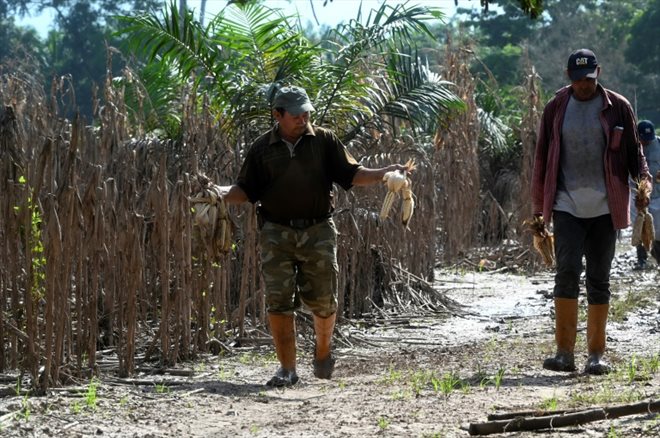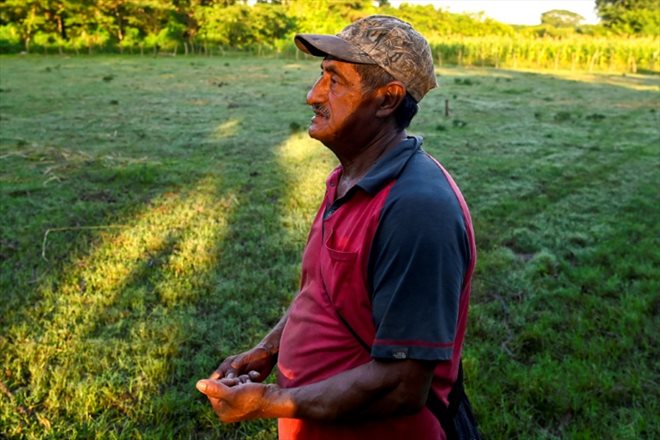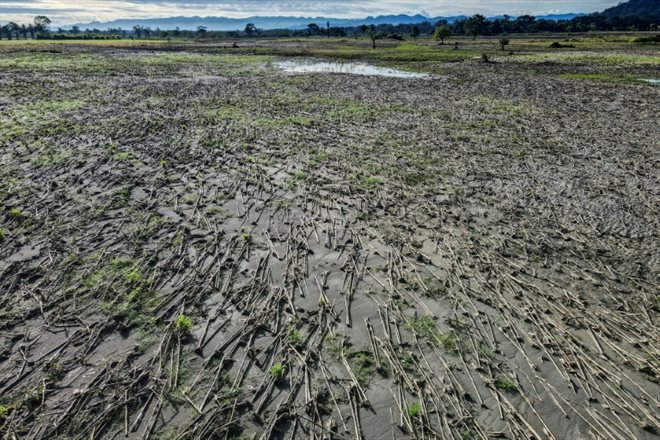Farmer Miguel Mejia (r) inspects his corn field after tropical storm Julia hit, on October 29, 2022 in El Progreso, Honduras (AFP/ORLANDO sierra)
Miguel Mejia was only able to save a handful of corn cobs in his flooded field after Tropical Storm Julia passed through Honduras last month, hitting Central America, a region of the world where extreme weather events are increasingly recurrent.
Julia entered Nicaragua on October 9 as a Category 1 hurricane, passed through El Salvador as a tropical storm, and dissipated in neighboring Guatemala.
The torrential rains that accompanied it forced the Ulua and Chamelecon rivers out of their beds, causing the greatest damage in Honduras, in the Sula Valley (north).
In these four Central American countries bathed by the Caribbean Sea or the Pacific Ocean, Julia caused the death of more than 50 people and destroyed thousands of hectares of crops.
The seven hectares owned by Miguel Mejia with nine other Honduran farmers are located near El Progreso, 30 kilometers from San Pedro Sula, the country’s second largest city and industrial capital.
A month after Julia’s passage, the scars are still visible with here and there debris carried by the flood which washed away all the crops: bananas, cassava, etc.
“The crops have been lost. There is going to be a food crisis,” laments the 58-year-old who lives with his wife and two adult children.

Farmer Miguel Mejia (L) searches for undamaged corn cobs in his field after Tropical Storm Julia hit, on October 29, 2022 in El Progreso, Honduras (AFP/Orlando SIERRA)
He estimates at more than 400,000 lempiras, about 16,000 dollars, the losses for the community of 10 farmers who will not be able to start a second sowing because of land still bathed in muddy water.
In the meantime, Miguel Mejia earns “enough to survive” by repairing the fences damaged by the rising waters.
– “Never had so much water” –
In El Salvador, 44-year-old Victor Carranza was also unable to harvest the corn “that sustains the family” on his hectare of flooded land in El Zamorano, about 100 km southeast of San Salvador. “Everything was lost because of the water,” he laments, hoping for government aid to start the next sowings.

Farmer Alfredo Hernandez in his field after tropical storm Julia hit on November 1, 2022 in Jiquilisco, El Salvador (AFP/Marvin RECINOS)
“There has never been so much water as this year”, breathes Alfredo Hernandez, a 51-year-old farmer who says he is “very worried”: “If the government or certain institutions do not support us, it will be worse tomorrow because at the moment we can’t even feed our cattle”.
In Nicaragua, the Ministry of Finance estimated at 367.8 million the cost of the damage caused by Julia on both agriculture and infrastructure.
The Guatemalan Minister of Agriculture, José Angel Lopez, counted “60,000 hectares of crops affected at different levels”, referring to corn, beans, cardamom, coffee, bananas and pastures.
“The big floods were every 20 years, but now it’s coming back two years later,” says Miguel, referring to hurricanes Eta and Iota which caused more than 200 deaths and billions in damage in 2020 in Central America.
“Before that there was Mitch, 24 years ago”, the second deadliest hurricane in the Atlantic basin, he recalls.

Corn fields destroyed after tropical storm Julia hit on November 3, 2022 in Santa Marta Salinas, Guatemala (AFP/CARLOS ALONZO)
After the passage of the category 5 hurricane which killed nearly 20,000 people in 1998, the Honduran authorities erected stone buttresses on the banks of the Ulua and Chamelecon rivers.
But they gave way under the effect of Eta and Iota, devastating the Sula Valley, the economic lung of the country of 9.6 million inhabitants, of whom more than 70% are poor.
© 2022 AFP
Did you like this article ? Share it with your friends with the buttons below.




